Foraging is not only an essential survival skill to have honed if you ever find yourself in a survival situation, it should also be a vital part of your prepping and food security plan.
Free resources abound, thanks to nature, and all preppers should be taking advantage of them – especially when it comes to harvesting hickory nuts and the nut offering of all native trees in general.
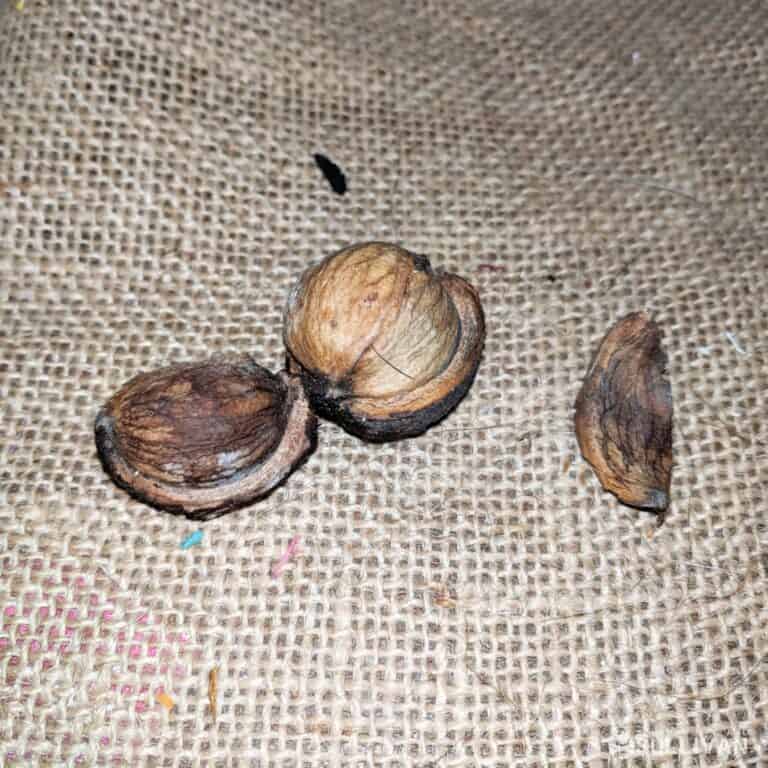
There are 19 different varieties of hickory trees. Hickory nuts, which are full of vital nutrients, can be eaten raw, roasted, cooked, and used to smoke meat and fish. When preserved properly, hickory nuts have an amazingly long shelf-life.
If you are a rural prepper (which is the best type of prepper to be) odds are the woods and fields around your home are robust bounty of edible, medicinal, and useful foraging materials.
Even if you are prepping in a suburban or urban environment, foraging for hickory nuts near where you live (or while hiking along a trail) can still be possible.
If you are not prepping for emergencies in a metropolitan environment, learning how to forage the hickory nuts and other offerings of wooded areas should become a priority on your survival skills “to do” list.
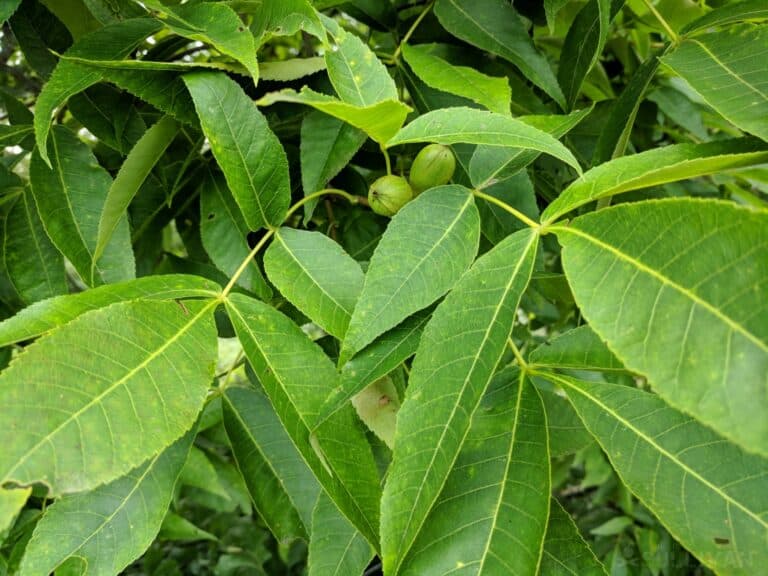
Table of Contents
Are Hickory Nuts Edible?
Yes, hickory nuts are definitely edible. You may read or have been told that only some types of hickory nuts are edible, but that is untrue. No type of hickory nut is poisonous to humans.
The misconception about the consumption of hickory nuts probably relates to the intensely bitter taste the produce from some tree varieties cause. Like with acorns, this bitter taste can be “leached out” during the boiling process.
Hickory Nut Nutrients
| Vitamin A | Iron |
| Magnesium | Potassium |
| Riboflavin | Zinc |
| Niacin | Copper |
| Phosphorus | Pantothenic Acid |
| Calcium | Vitamin B6 |
| Vitamin C | Thiamin |
Hickory nuts contain no sodium, cholesterol, trans fat, and a very small percentage of saturated fat. A standard size hickory nut contains approximately 19 calories.
Hickory Nut Uses
- To eat raw or roasted.
- Hickory nuts can be added to muffins, cookies, and even pies for flavor, a nutrient boost, and added calories.
- Make pancake syrup.
- After boiling the hickory nuts, they can be tossed to the chickens for a nutrient-rich treat.
- Make hickory oil from the liquid that is left after boiling the nuts.The cooled oil is known as “hickory nuts butter”, and is great for flavoring stews, meats, soups, and baked goods.
- You can make hickory milk, which is akin to almond milk.
- Native Americans used the fatty sweet part of the nut – commonly referred to as the “meat” to make a porridge.
Facts
- Hickory trees are part of the Carya genus of the walnut family.
- In the United States and across North America, the 18 species of nut producing trees grow primarily in the Midwest, New England, and Southeast regions. They are hardy enough to grow in USDA agricultural zones 4 through 8.
- All breeds of hickory trees range from 50 to 100 feet tall.
- The tops of hickory trees can spread out approximately 40 feet wide.
- Hickory trees typically thrive in partial shade and in soil that is well-draining and moist.
- Several varieties of hickory trees, like the popular shagbark or shellbark, are capable of living for several hundred years. The shellbark hickory tree is also commonly referred to as the kingbark.
- Shellbark, shagbark, and the southern shellbark hickory trees look nearly identical. The southern shellbark prefers limestime soil to grow in and the shagbark often grows on hills in dry soil.
- Shagbark hickory trees produce the smallest nuts and shellbark hickory trees produce the largest nuts – hence its “king” nickname.
- Both squirrels and bats love to take up residence in shellbark and shagbark hickory trees – a good tidbit to know if hunting during a SHTF scenario.
- Other high-producing and frequently found hickory tree varieties include: pignut, scrub, black, nutmeg, sand, mockernut, red, bitternut, and pecan.
- Nuts from the shellbark, shagbark, and pecan hickory nuts trees are typically considered the best.
- Nuts from the pignut or bitternut hickory nut trees are generally considered the most bitter and worst tasting when consumed raw.
- While hickory nuts are not poisonous to dogs, they can cause laminitis if consumed by horses.
- Squirrels, ducks, chickens, deer, and turkey love to eat hickory nuts – making them a great free and readily available source of bait during a survival hunting scenario.
- Hickory trees do not have any poisonous look-alikes.
- This nut tree species is monoecious – it boasts both male and female flowers growing separately on each open. The female flowers look like spikes, and have between two to 10 separate and individual flowers. The male flowers are yellow- to green-shaded catkins.
- The pith is the portion of the tree that is located at the center column of the branches. All varieties of hickory trees will have a pith with five sides, are solid, and have a tan color. The five sides should look like a star where they form together if it is a hickory tree. To see whether or not the pith is solid and the other features noted above, you will need to cut off just a tiny portion of a living branch – making sure to cut it in half longways.
How to Identify Hickory Trees
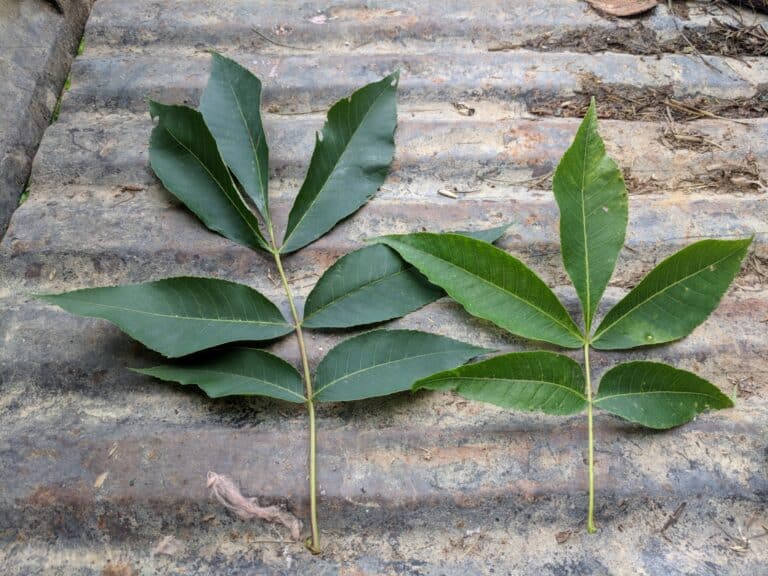
Hickory Nut Tree Leaf Identification
- Hickory nut leaves range in size from 2 to 8 inches long.
- Some hickory nut leaves have serrated edges with sharply pointed “teeth”, but others have rounded serrated edges.
- Multiple long and narrow leaves grow from each rachis – or stalk, the amount of leaves vary. A shellbark hickory tree rachis boasts seven leaves and a shagbark tree stem has five leaves. There can be as many as 17 leaves on a single leaf stalk.
- The leaves are positioned opposite of each other on the rachis with one single leaf always pointing straight out at the top.
- The leaf at the end of the stalk is longer and wider than the rest.
- The bark on hickory trees trunk grows in a vertical ridge pattern. Depending upon the variety of hickory tree, the ridges could be nestled tightly together or spread apart.
Shellbark Hickory Tree Identification
- Leaves on a shellbark – or king bark hickory tree range in size between one and one-eighth of an inch long to a little over two and a half inches long.
- There are 7 to nine 9 on each stalk.
- The leaves are a medium shade of green, look somewhat waxy, and smooth edging.
- The husk on shellbark hickory trees is extremely thick, and a dark brown color. The nutmeat in a shellbark hickory nut is very sweet.
- Twigs on this hickory variety have rounded bulbs, and are green to brown in color.
- Bark on the shellbark hickory nut tree is arranged in narrow and long scales that peel away from the tree from both the top and the bottom over time.
Bitternut Hickory Tree Identification
- This type of hickory tree has a stalk that grows nine leaves. The leaves have rounded serrated edges and are both smooth and broad.
- The nuts on a bitternut hickory tree range in size from an eighth of an inch to a little of one and a half inches long.
- The husk on bitternuts is a dark brown in shade, and rather thin.
- The twigs are green in color, slender in shape, and boast yellow buds.
- Bark on the bitternut tree is light gray to brown, and does not split widely, deeply, or flake.
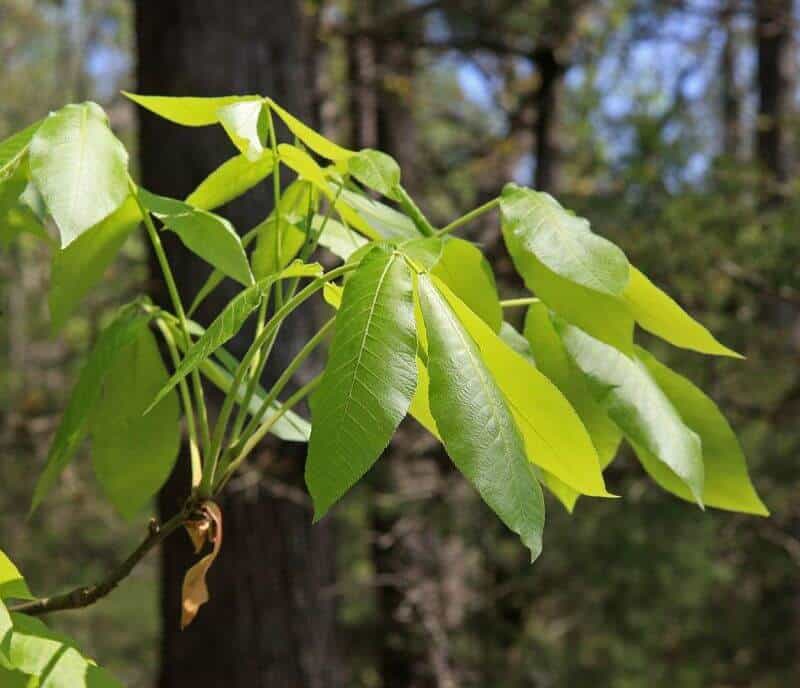
Shagbark Hickory (Carya ovata) Tree Identification
- Leaves on this variety of hickory tree have pointed tips, come five to seven on each stalk, are a shade of light green and are more rounded and shorter than some other varieties in the breed.
- Shagbark hickory trees have shaggy bark is thick and boasts a scaly look.
- Shagbark hickory nuts range in length from a little more than one inch to two inches. They are also one inch in diameter.
- The husk on shagbark nuts are thick, range in color from brown to black when mature, and taste very sweet.
- Twigs are brown in color and thick.
Southern Shagbark Hickory Tree Identification
- The rachis on this hickory tree has five leaves with jagged serrated edges.
- The nuts it produces range in length from a little over one inch to two inches long.
- A southern shagbark tree features scaley bark.
- The twigs on this type of hickory tree are thick and brown.
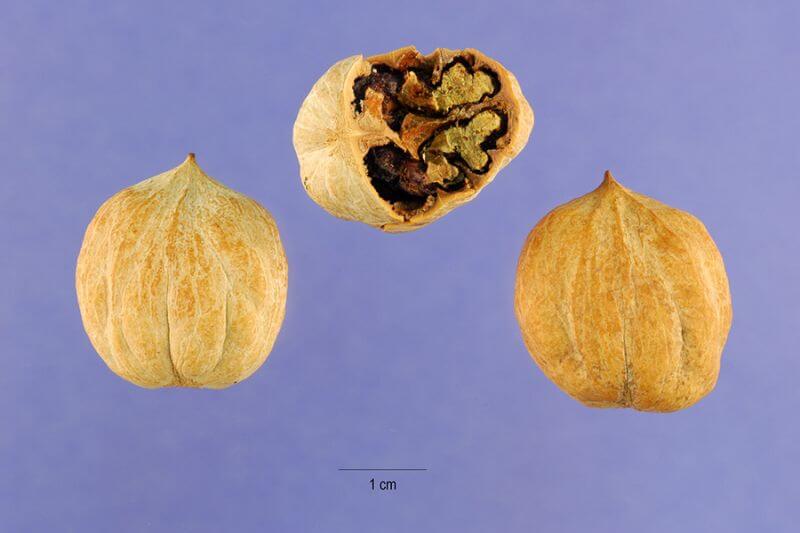
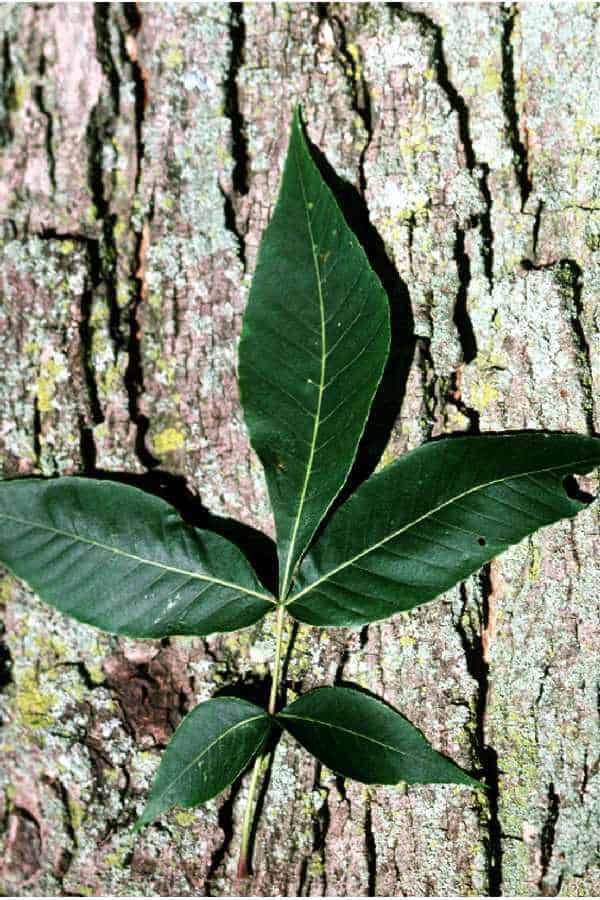
Pignut Hickory Tree (Carya glabra) Identification
- The leaves on this hickory nut tree are serrated, grow five to a rachis, are a bit shiny, and dark green in color.
- The husk on a pignut is thin and light brown in color, and more rounded than some other varieties of hickory nuts.
- Pignuts are typically one inch long, and an eighth of an inch wide and have a light brown hue.
- Twigs on this type of hickory nut tree range in shade from light green to a dark purple and are slender.
- Pignut tree bark is heavily recessed, and has a scaly face, but does not plate – flake, at the edges.
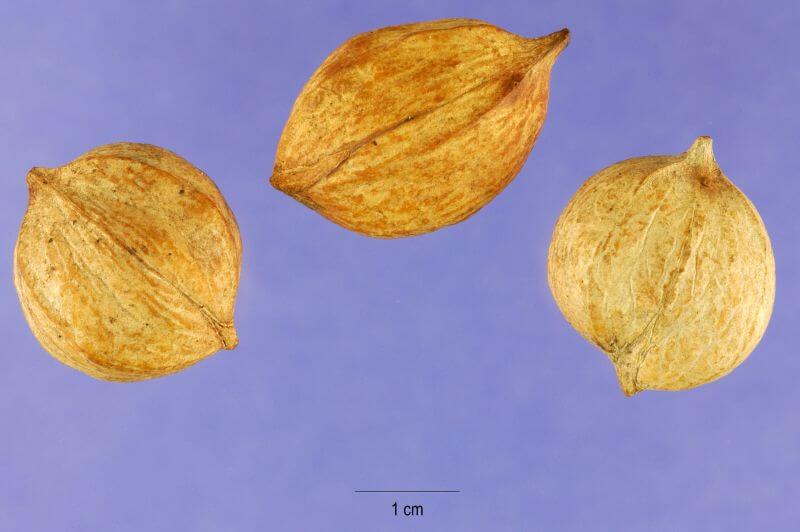
Mockernut
- There are a minimum of seven leaves on a mockernut hickory tree rachis.
- The leaves on this variety of hickory nut tree are rounded, have a slightly waxy texture, come in a medium shade of green, and are fairly wide.
- The edges of leaves on the mockernut hickory trees are serrated only slightly with a dull and not pointy edge on the teeth.
- Nuts from this hickory tree are approximately one and a half to two inches long.
- Mockernut hickory tree nuts have a husk that is dark brown with a thick shell.
- Bark on this tree flakes away at its furled edges as it grows and matures.
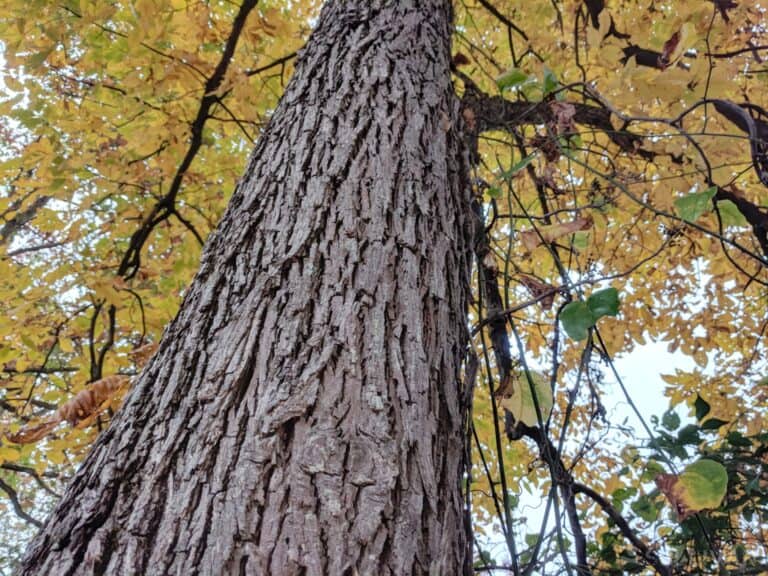
Red Hickory Tree (Carya ovalis) Identification
- Leaves on the red hickory tree are tapered, boast a red and green hue, and have a tapered shape.
- There are five leaves on each rachis. Each one is serrated with a smooth edge.
- Bark on this hickory tree variety is heavily ridged with narrow strips that are rough to the touch but do not flake.
- Red hickory nuts are typically one inch to one and one-eighth of an inch long.
- The nut outer husk is thin, round, and wide. The hickory nut meats inside tastes sweet.
Sand Hickory Tree Identification
- This hickory tree variety has light green and narrow leaves.
- Each of the leaflets has a smooth edge.
- Nuts form the sand hickory tree are only one half of an inch to a little less than one and a half inches long.
- The meat inside the shell is sweet, light in color, and the husks are thin.
- The round nuts are also covered in tiny and fine hairs.
- Bark on this variety of hickory tree is compact with narrow furrows that are fairly smooth in texture.
Is The Hickory Tree The Same as The Pecan Tree?
A pecan tree is sometimes referred to as a hickory tree, sweet pecan, or butternut tree. The pecan and the hickory trees are from the same genus but not the same species.
Differentiating between the wood produced by a pecan and a hickory tree can be difficult to an untrained eye. A hickory tree is self-pollinating and a pecan tree is not.
Using Hickory Nuts to Smoke Meat and Fish
Hickory nuts have been used to smoke both meat and fish for hundreds of years. The sweet flavor of some varieties of hickory nuts infuse into the meat or fish to create a moist and delicious taste. Smoking pork and beef ribs with hickory nuts has become quite popular in some BBQ circles.
Smoking meat or fish with the fruit from hickory tree nuts is strongly discouraged, even if you boil the nuts first to leech them. But, the outer husks and shells from bitter nuts still make excellent feed supplements for poultry birds.
What Time of Year Can You Find Hickory Nuts?
During the first few weeks of October in the fall, as the trees shed their leaves, is the best time to find hickory nuts. You will be looking down and not up when foraging hickory nuts. Regardless of variety, nuts fall from the tree once they are mature, only the “green” nuts are still hanging from the tree.
Expect to be racing the squirrels for the nuts, who don’t mind running up a tree and munching down on less than mature hickory tree offerings.
When in the woods foraging for hickory nuts (and acorns and walnuts as well) use both your ears and your eyes to guide you. It is not unusual to hear (sometimes even feel) a mass of nuts from multiple trees releasing at nearly the same time and falling to the ground with tiny thuds.
This effect is significantly increased when in the presence of hickory and oak trees. There has been many years of steady thumping on the front of my car as it’s parked underneath an oak tree.
If the weather forecast is predicting a storm or significant winds, expect all of the nut bearing trees in your area to drop a great abundance of nuts – even if they are not yet ripe.
When an early hard frost is experienced, nuts can also fall before they are mature, reducing the amount of nuts that can be used for human consumption, but can still be collected for smoking or to be used as a livestock feed supplement.
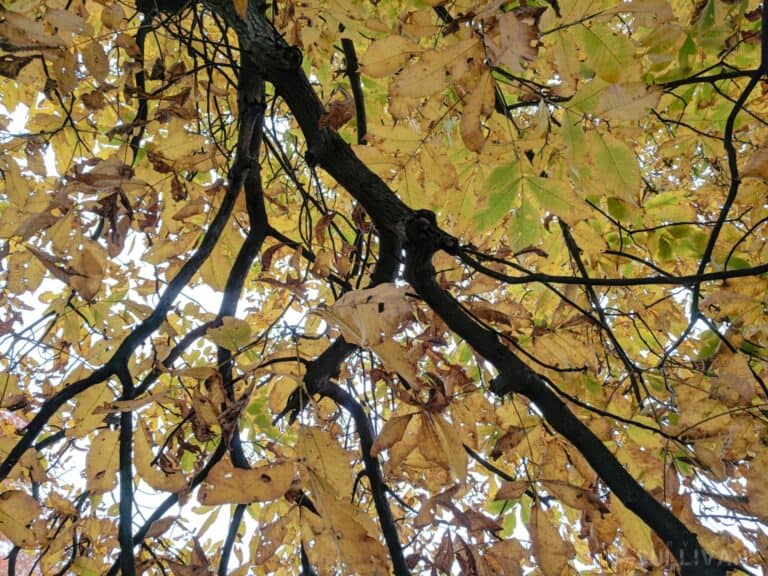
The Difference Between a Hickory Nut And a Walnut
The husks on both a hickory nut and a walnut tree are the easiest way to differentiate between the two trees. It is the shagbark hickory tree that produces a nut so large and initially green in color that it is often confused for a walnut by novice foragers.
A walnut husk has a spongy type feel, and it is not even half as hard as a hickory nut – not even a shagbark hickory nut. Walnut husks are also slightly corrugated, as is a shellbark nut to some degree, but the surface on the fruit from the hickory nut is smooth and not rough like a walnut.
Harvesting Shagbark Hickory Nuts
As with other nuts, a shagbark hickory nut will fall from the tree when it is mature. While it might be tempting to pick one of the huge nuts from the tree, doing so will likely stunt its growth.
Once shagbark hickory nuts have fallen from the tree and you manage to snag them before the eager squirrels, you simply use a knife to cut the thick husk into quarters and then crack the nut to garner the meat inside.
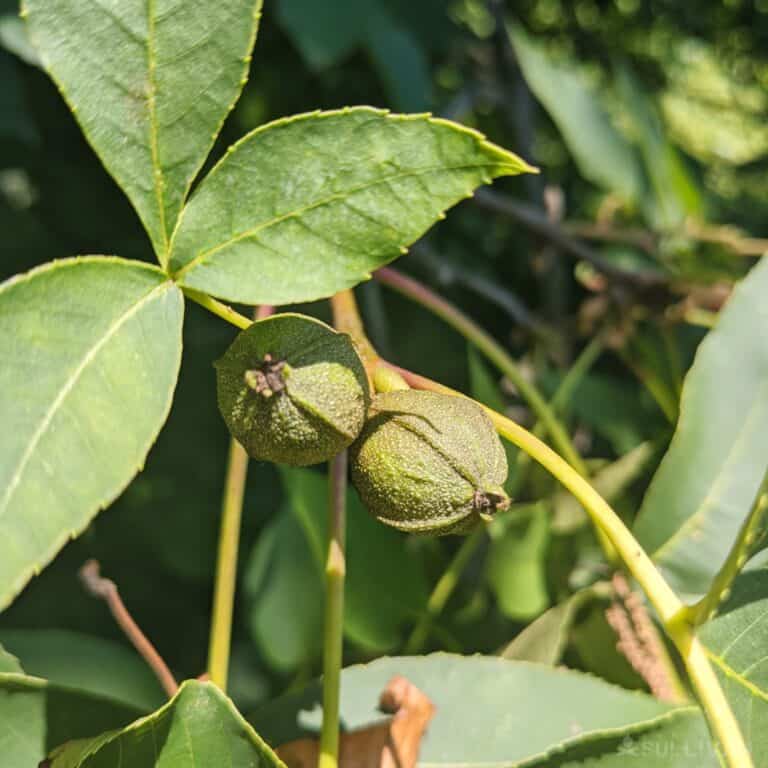
Squirrels are not the only wildlife that love to munch down on nuts from other hickory trees. Woodpeckers, foxes, grosbeaks, blue jays, most wild duck species, and bobwhites also love the nuts from these trees.
A shagbark hickory tree produces nuts in a 3-year cycle once it reaches maturity.
The yield from the tree will likely vary sharply during this cycle.
How Long Do Hickory Nuts Last?
When stored in a container (cardboard box works great) at 35 F (1 C), hickory nuts should remain good to use for about 24 months.
They begin drying right after they are harvested, but to keep the kernels inside of the nuts nice and crisp, they have to be stored out of direct sunlight in a cool, dry place.
Storage
Dried hickory nuts should be kept in a place like a root cellar, garage, or a basement for at least one month – providing that the air has good ventilation and is dry. When frozen, the meat inside of the hickory nuts should remain safe to eat for months.
Before storing hickory nuts, check them over really well for signs of weevils. If there is a hole in the husk, that is a good indication that an insect has already gotten inside. Perform the sink or float test to help determine if you have a good nut or a bad one.
The best way to do this is by getting a bucket or buckets of water and drop your haul in them. Filling the remainder of the bucket with water will then complete the test as the bad nuts will float and the edible nuts will stay at the bottom.
Speaking of pests, keep in mind most rodents such as mice, squirrels and raccoons are very fond of nuts, and will gladly feast on your stockpile – unless you take adequate precaution measures.
How to Crack Hickory Nuts
Nuts from hardwood hickory nut trees are notoriously difficult to crack. You can use a manual nutcracker on hickory nuts (or any other type of nut such as black walnuts or English walnuts) like the one below, but opening them this way to get the meat out will still be both frustrating and tiring.
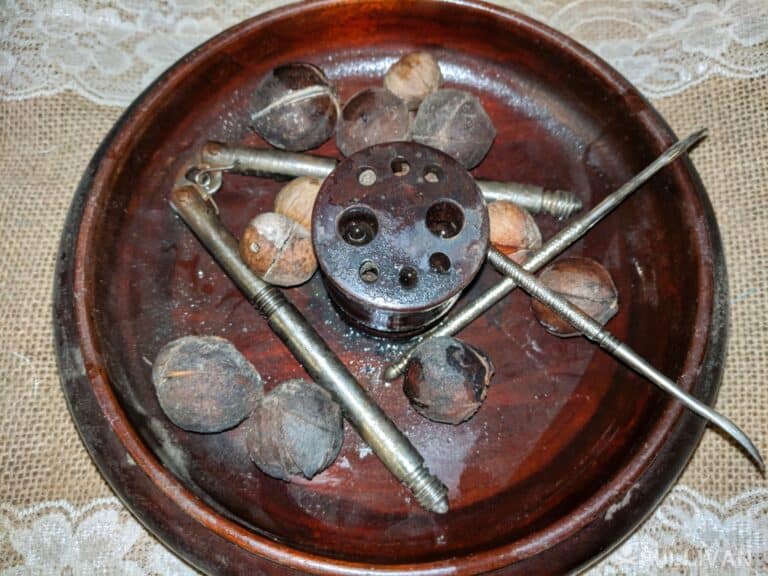
The easiest (if you can call it that) way to open a hickory nut is with a hammer and a hard surface.
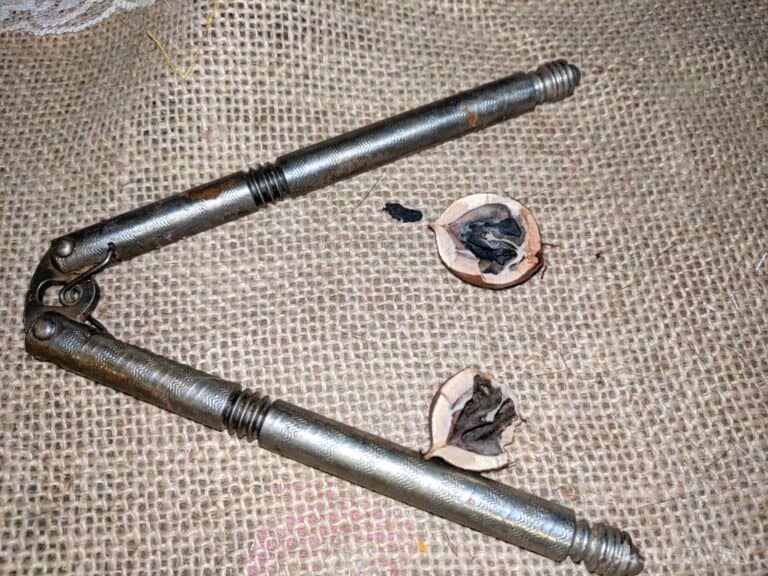
- Place the nut on its side – or hold it carefully if the hickory nut is extremely rounded and tends to roll.
- Raise the hammer just several inches above the hickory nut.
- Whack the hickory nut HARD.
- Repeat this process until all of your nuts are cracked, or your arms tire out and you need a break.
When cracked with a hammer, hickory nuts SHOULD break into multiple pieces and reveal the meat inside. But, it could take several whacks with a hammer to break open the nut completely.
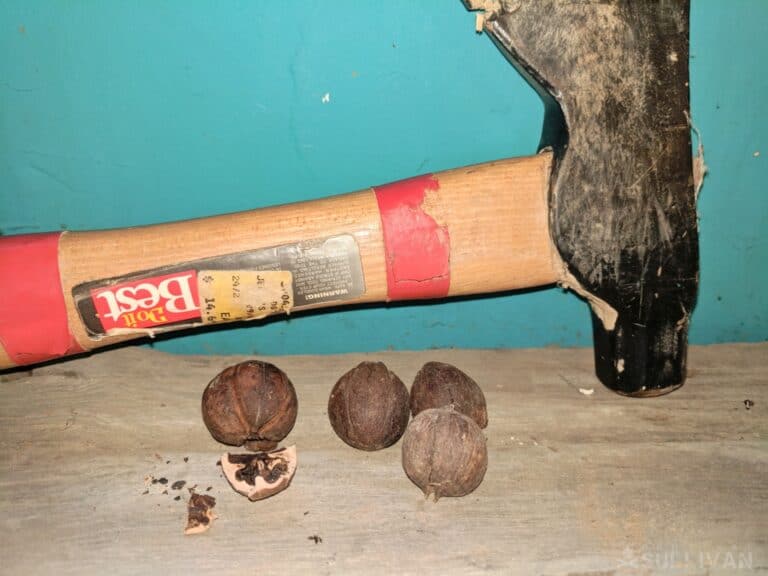
You might need a nut pick to help free any chunks of meat that will not release after cracking the nut:
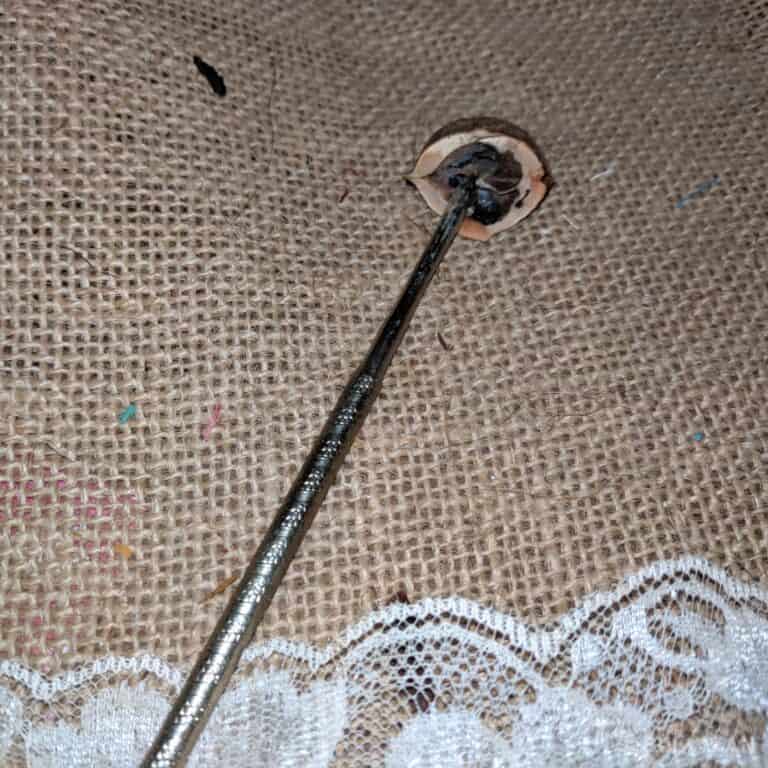
How to Dry Hickory Nuts
It takes roughly three days to one week to dry naturally. To make sure the nuts are dry before storing them away, give them a few shakes.
If you hear the nut meat moving about freely inside the shell, the nuts are sufficiently dried.
Roasting Hickory Nuts In The Oven
To roast hickory nuts in an oven, set the temperature at 300 F (148 C). If you want the roasted nuts to be a tasty treat, you should season them before roasting.
Roast hickory nuts for one and a half to two hours. After removing them from the oven and let them cool for approximately 40 minutes – or until they reach room temperature.
Roasted hickory nuts will not last as long as naturally dried hickory nuts. You should not eat hickory nuts that have been roasted once they are more than 21 days old.
How to Dehydrate Them
You can dehydrate hickory nuts in the oven or a dehydrating machine.
- To dehydrate nuts in the oven they must first be removed from their husk and shell.
- Soak the nuts in cold water overnight.
- Remove the nuts from the water and spread them out on a baking sheet if putting them in the oven of a dehydrator tray with a mesh liner after they have air dried post-soak.
- Set the temperature on the oven or dehydrator to 150 degrees F (65 C).
- Dry the nuts in the oven of the dehydrating machine for 12 to 24 hours, depending upon their thickness.
- Remove the nuts and store in an airtight container.
How to Make Nut Oil
You can use the oil from the hickory nuts you collected for cooking, baking, or making natural hair and beauty items like soap, chapstick, dry skin lotion, and shampoo.
If you have an oil press, you will only need to use cracked unroasted hickory nuts to make oil. If using a press, follow the manufacturer’s instructions for loading the nuts into the press at the proper amounts before pressing them into oil either manually or via a switch on an electronic machine.
If you are using a blender or a food processor to make nut oil, you need to combine one to two teaspoons of carrier oil for every 2 cups of unroasted and cracked nuts used.
- Place the nuts and oil into a food processor or blender.
- Blend at LOW speed for about three minutes. Blending at high speed will splatter the oil everywhere inside of the kitchen device, and don’t allow it to combine with the nuts either thoroughly or properly.
- When the nuts and oil form into a ball shape, stop the food processor or blender and turn it off.
- Scrap the ball shape into chunks and prepare to operate the machine again.
- Next, blend or process at a medium speed for several minutes.
- You will likely need to repeat step three at least one more time before switching to high speed.
- Blend or process the nut and oil mixture at high speed for a few minutes.
- Remove the mixture from the blender or food processor, and pour the sludge you have created into an airtight container.
- Store the container at room temperature for approximately 14 days to allow the oil from the nuts to separate fully from the nut meat.
- Drain the oil into another clean container that has a firm fitting lid to strain away any solids. Use a fine mesh strainer or several layers of cheesecloth when draining.
Some Delicious Hickory Nut Recipes
- Hickory Nut Shortbread Cookies – This hickory nuts cookie recipe is sweet with a bit of tangy – thanks to the orange zest that is mixed into the base ingredients. It takes just a half a cup of nuts and about 30 minutes to whip up a pan of three dozen delicious cookies.
- Grandma’s Hickory Nut Cake – This heirloom recipe would be yummy without the frosting, but the frosting truly makes this old-fashioned hickory nut cake a gourmet dessert. It takes a single cup of hickory nuts, some flour, salt, sugar and eggs, and about one hour from start to finish to create this exquisite cake.
- Hickory Nut Ambrosia – This twist on a drink that, according to legend, was favored by the Greek gods. It will take about two cups of hickory nuts to make this warm and rich drink over the course of about an hour. Flavoring the hickory nut ambrosia with honey or maple syrup (or both) makes it even more fantastic.
- Hickory Nut Pie – If you like pecan pie, you will also assuredly savor biting into a hickory nut pie, as well. You will need approximately 1 cup of hickory nuts to flour, and about an hour to make this amazing homemade pie – which even tastes good if you use a store-bought crust. Great with ice cream!
Ready To Start Foraging?
Hickory nuts are valuable in so many ways and can be found for free just laying on the ground. All you have to do is find some mature hickory trees on your land or in a place that you are given permission to forage, wait for fall, and then fill up a sturdy sack with as many as you can carry.
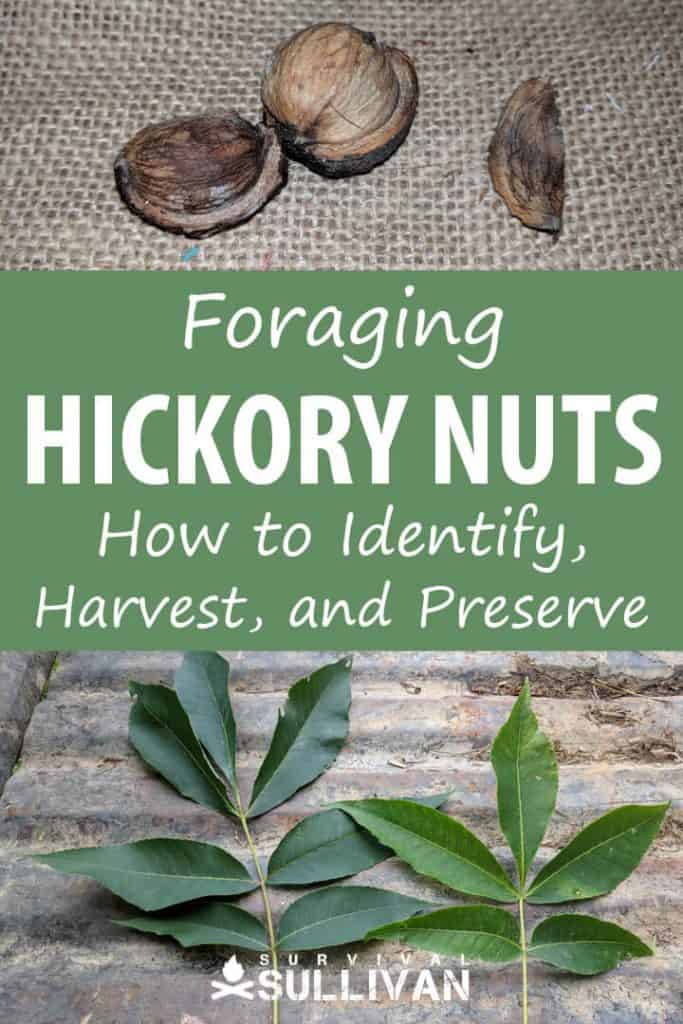

Tara Dodrill is a homesteading and survival journalist and author. She lives on a small ranch with her family in Appalachia. She has been both a host and frequent guest on preparedness radio shows. In addition to the publication of her first book, ‘Power Grid Down: How to Prepare, Survive, and Thrive after the Lights go Out’, Dodrill also travels to offer prepping tips and hands-on training and survival camps and expos.

That nut they are cracking is no good! It is rotten and black. (?)
our nuts went black & shriveled within days of harvest, they were freshly fallen & hulled right away, then cracked to dry. what did we do wrong?!?
You shouldn’t crack them before drying them. Let them dry whole after you take the green hulls off.
Hi there. You seem to be quite knowledgable about hickory nuts, and I was hoping you might be able to help me out. My husband and I harvested our shellbark and shagbark hickory nuts this year for the first time and while drying, the shellbark nuts developed hairline cracks. (Exactly like the crack in the shellbark nut in your picture.) The shagbark nuts did not do this. The nut inside the cracked shells are good as of right now but I am unsure if these nuts will keep through the winter when stored. I am fearful that the cracks might make them susceptible to mold and/or drying too much and shriveling. Do you have any ideas why our shellbark nuts have developed these cracks? We had a mild drought this year and I wonder if it might have something to do with it. We did use a hammer to break the hulls open originally, but after we noticed the cracks were appearing, we stopped using the hammer and the new batch still developed the hairline cracks while drying. We let the latest batch lay out in the yard for a bit and I just went to collect the nuts today and the ones that had the hulls half cracked open had already developed the hairline cracks. I am at a loss. What is causing this, or is it normal? And if so, can they be stored through the winter? I would very much so appreciate your angle on this.
Do you crack the nuts before you give to chickens? Or can they figure it out themselves?